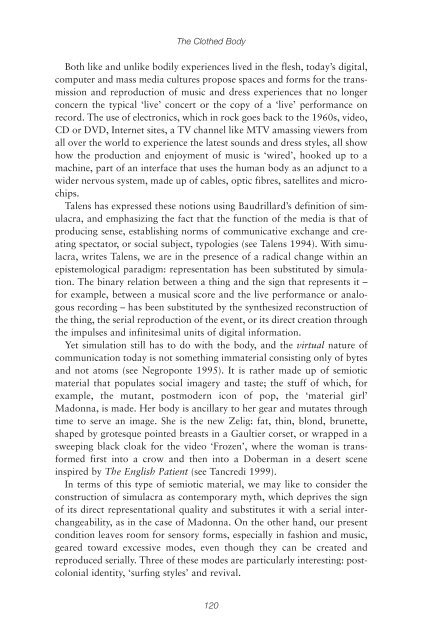Create successful ePaper yourself
Turn your PDF publications into a flip-book with our unique Google optimized e-Paper software.
<strong>The</strong> <strong>Clothed</strong> <strong>Body</strong><br />
Both like and unlike bodily experiences lived in the flesh, today’s digital,<br />
computer and mass media cultures propose spaces and forms for the transmission<br />
and reproduction of music and dress experiences that no longer<br />
concern the typical ‘live’ concert or the copy of a ‘live’ performance on<br />
record. <strong>The</strong> use of electronics, which in rock goes back to the 1960s, video,<br />
CD or DVD, Internet sites, a TV channel like MTV amassing viewers from<br />
all over the world to experience the latest sounds and dress styles, all show<br />
how the production and enjoyment of music is ‘wired’, hooked up to a<br />
machine, part of an interface that uses the human body as an adjunct to a<br />
wider nervous system, made up of cables, optic fibres, satellites and microchips.<br />
Talens has expressed these notions using Baudrillard’s definition of simulacra,<br />
and emphasizing the fact that the function of the media is that of<br />
producing sense, establishing norms of communicative exchange and creating<br />
spectator, or social subject, typologies (see Talens 1994). With simulacra,<br />
writes Talens, we are in the presence of a radical change within an<br />
epistemological paradigm: representation has been substituted by simulation.<br />
<strong>The</strong> binary relation between a thing and the sign that represents it –<br />
for example, between a musical score and the live performance or analogous<br />
recording – has been substituted by the synthesized reconstruction of<br />
the thing, the serial reproduction of the event, or its direct creation through<br />
the impulses and infinitesimal units of digital information.<br />
Yet simulation still has to do with the body, and the virtual nature of<br />
communication today is not something immaterial consisting only of bytes<br />
and not atoms (see Negroponte 1995). It is rather made up of semiotic<br />
material that populates social imagery and taste; the stuff of which, for<br />
example, the mutant, postmodern icon of pop, the ‘material girl’<br />
Madonna, is made. Her body is ancillary to her gear and mutates through<br />
time to serve an image. She is the new Zelig: fat, thin, blond, brunette,<br />
shaped by grotesque pointed breasts in a Gaultier corset, or wrapped in a<br />
sweeping black cloak for the video ‘Frozen’, where the woman is transformed<br />
first into a crow and then into a Doberman in a desert scene<br />
inspired by <strong>The</strong> English Patient (see Tancredi 1999).<br />
In terms of this type of semiotic material, we may like to consider the<br />
construction of simulacra as contemporary myth, which deprives the sign<br />
of its direct representational quality and substitutes it with a serial interchangeability,<br />
as in the case of Madonna. On the other hand, our present<br />
condition leaves room for sensory forms, especially in fashion and music,<br />
geared toward excessive modes, even though they can be created and<br />
reproduced serially. Three of these modes are particularly interesting: postcolonial<br />
identity, ‘surfing styles’ and revival.<br />
120

















